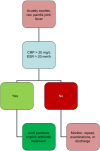Septic arthritis in children: diagnosis and treatment
- PMID: 29388627
- PMCID: PMC5774603
- DOI: 10.2147/PHMT.S115429
Septic arthritis in children: diagnosis and treatment
Abstract
Acute septic arthritis in children is usually hematogenous. It is more common in boys, and it most often affects the large joints of the lower limb. Diagnosis is based on cultures obtained from the infected joint and is supported by C-reactive protein blood test or ultrasound imaging. Staphylococcus aureus is the most common causative agent and is the primary target for empiric treatment. First-generation cephalosporins and clindamycin are suitable antibiotics. Vancomycin is utilized in areas with high rates of clindamycin- and methicillin-resistant S. aureus. After a short intravenous administration of 2-4 days, a total course of 2 weeks is sufficient in uncomplicated cases. Early antibiotic treatment has significantly improved the prognosis in high-income settings, but uncomplicated recovery is compromised if the treatment is delayed. Complications such as symptomatic osteoarthritis or avascular necrosis of the femoral head develop slowly. A long follow-up of 1-2 years is required to detect all possible sequelae.
Keywords: Staphylococcus aureus; child; sepsis; septic arthritis.
Conflict of interest statement
Disclosure The author reports no conflicts of interest in this work.
Figures
Similar articles
-
Acute hematogenous osteomyelitis and septic arthritis in children: clinical characteristics and outcomes study.J Med Assoc Thai. 2011 Aug;94 Suppl 3:S209-16. J Med Assoc Thai. 2011. PMID: 22043778
-
Is Intraarticular Antibiotic Administration Effective in the Treatment of Methicillin-Resistant Staphylococcus aureus?Acta Chir Orthop Traumatol Cech. 2019;86(4):276-280. Acta Chir Orthop Traumatol Cech. 2019. PMID: 31524589 English.
-
[A multicentric study on clinical characteristics and antibiotic sensitivity in children with methicillin-resistant Staphylococcus aureus infection].Zhonghua Er Ke Za Zhi. 2020 Aug 2;58(8):628-634. doi: 10.3760/cma.j.cn112140-20200505-00469. Zhonghua Er Ke Za Zhi. 2020. PMID: 32842382 Chinese.
-
Diagnosis and management of acute osteoarticular infections in children.Paediatr Child Health. 2018 Aug;23(5):336-343. doi: 10.1093/pch/pxy049. Epub 2018 Jul 18. Paediatr Child Health. 2018. PMID: 30653632 Free PMC article. Review.
-
Simplifying the treatment of acute bacterial bone and joint infections in children.Expert Rev Anti Infect Ther. 2011 Dec;9(12):1125-31. doi: 10.1586/eri.11.140. Expert Rev Anti Infect Ther. 2011. PMID: 22114963 Review.
Cited by
-
Substrate-derived Sortase A inhibitors: targeting an essential virulence factor of Gram-positive pathogenic bacteria.Chem Sci. 2023 May 31;14(25):6975-6985. doi: 10.1039/d3sc01209c. eCollection 2023 Jun 28. Chem Sci. 2023. PMID: 37389257 Free PMC article.
-
Neuroblastoma Masquerading as a Septic Hip Infection in a Three-Year-Old.Cureus. 2023 Mar 19;15(3):e36350. doi: 10.7759/cureus.36350. eCollection 2023 Mar. Cureus. 2023. PMID: 37082496 Free PMC article.
-
Clinical characteristics of children with septic arthritis caused by different pathogenic bacteria.Pediatr Discov. 2025 Jan 10;3(1):e2522. doi: 10.1002/pdi3.2522. eCollection 2025 Mar. Pediatr Discov. 2025. PMID: 40626293 Free PMC article.
-
Native Joint Septic Arthritis.Antibiotics (Basel). 2024 Jun 27;13(7):596. doi: 10.3390/antibiotics13070596. Antibiotics (Basel). 2024. PMID: 39061278 Free PMC article. Review.
-
Neonatal Septic Arthritis with Acyanotic CHD: A Case Study.J Orthop Case Rep. 2024 Aug;14(8):85-88. doi: 10.13107/jocr.2024.v14.i08.4656. J Orthop Case Rep. 2024. PMID: 39157482 Free PMC article.
References
-
- Krogstad P. Osteomyelitis and septic arthritis. In: Feigin RD, Cherry JD, editors. Textbook of Pediatric Infectious Diseases. 6th ed. Philadelphia, PA: Saunders; 2009. pp. 725–748.
-
- Pääkkönen M, Peltola H. Management of a child with suspected acute septic arthritis. Arch Dis Child. 2012;97(3):287–292. - PubMed
-
- Pääkkönen M, Kallio MJ, Lankinen P, Peltola H, Kallio PE. Preceding trauma in childhood hematogenous bone and joint infections. J Pediatr Orthop B. 2014;23(2):196–199. - PubMed
-
- Ju KL, Zurakowski D, Kocher MS. Differentiating between methicillin-resistant and methicillin-sensitive Staphylococcus aureus osteomyelitis in children: an evidence-based clinical prediction algorithm. J Bone Joint Surg Am. 2011;93(18):1693–1701. - PubMed
LinkOut - more resources
Full Text Sources
Other Literature Sources
Research Materials



